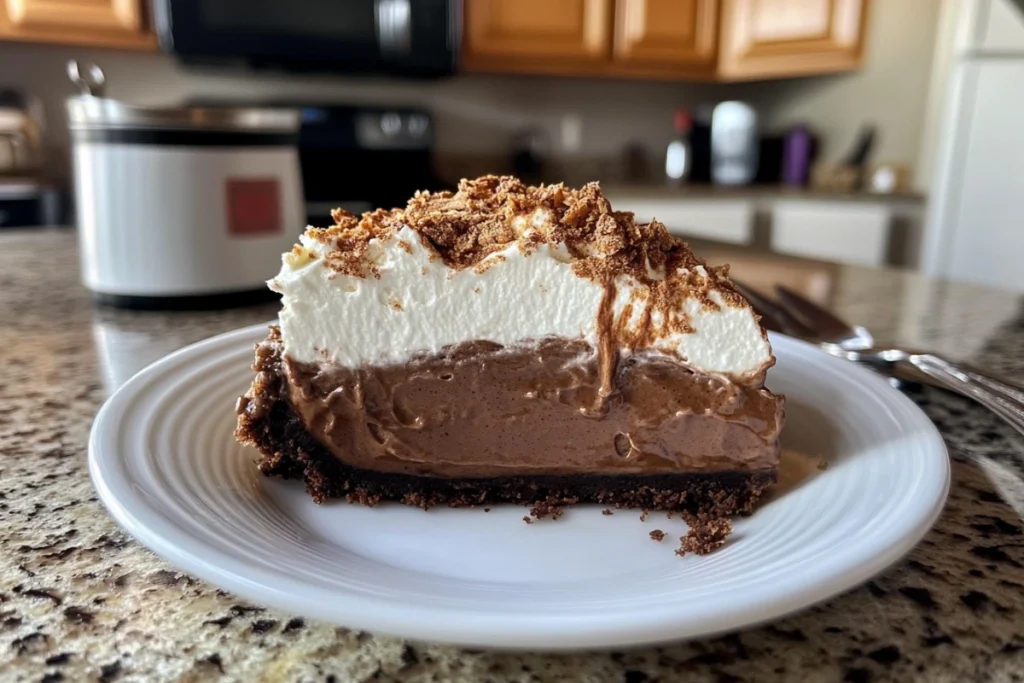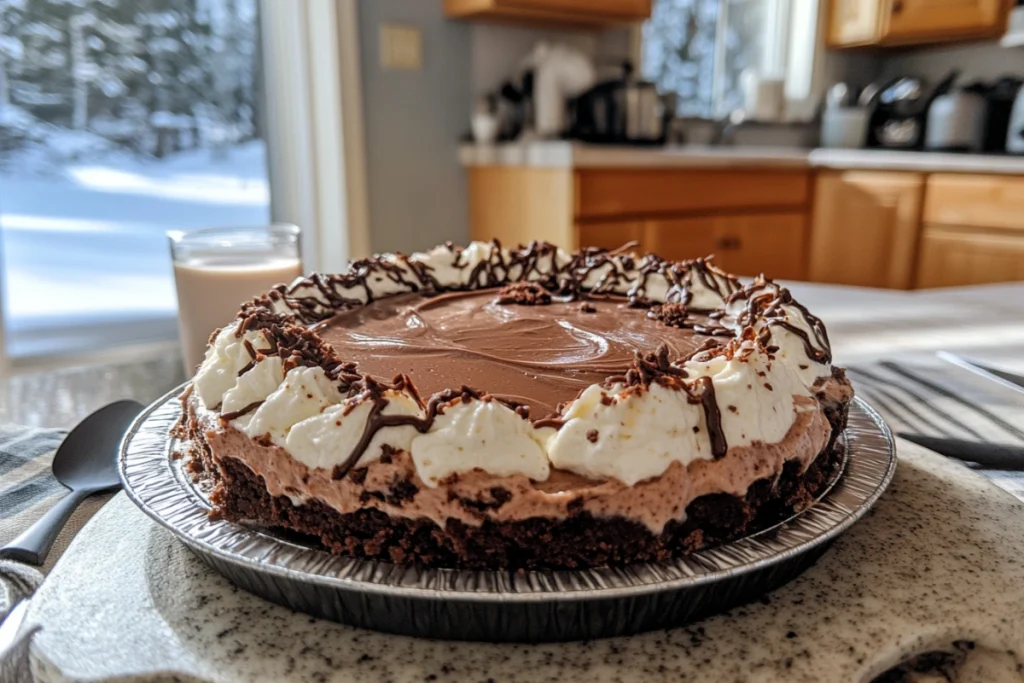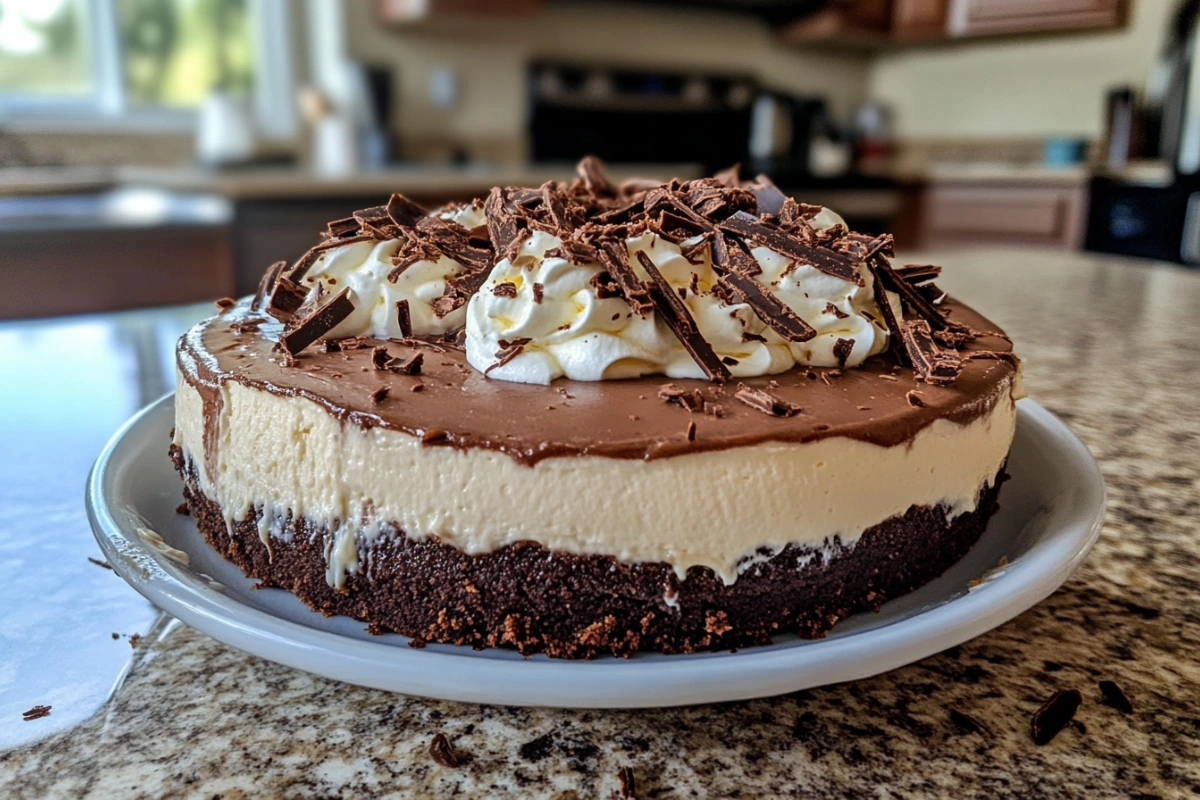Part 1: Introduction to French Silk Pie
French Silk Pie—a dessert that evokes images of smooth, velvety chocolate and buttery, flaky crust—has been a favorite for many across the United States. But, did you know that despite the name, it doesn’t actually come from France? The mystery of Where Did French Silk Pie Originate is a fascinating story that intertwines American culinary ingenuity and the rise of chocolate desserts in the 20th century.
In this article, we’ll unravel the history behind this beloved pie, explore how it came to be, and dig deeper into the origins of its elegant name. But first, let’s take a closer look at its creation and who exactly can be credited with bringing it to life.
Part 2: The Birth of French Silk Pie
Who Invented French Silk Pie?
The journey of French Silk Pie starts in the mid-20th century, a time when the American dessert scene was evolving rapidly. While many credit French Silk Pie as an iconic American invention, its origins are tied directly to the Baker’s Chocolate Company. In fact, the company played a huge role in its creation, acting as the catalyst for the pie’s rise in popularity.
In the early 1950s, Betty Cooper, a baker and home cook, sought to create a chocolate dessert that was unlike anything people had tasted before. At the time, Baker’s Chocolate had launched a new type of chocolate known for its smooth texture, making it the perfect ingredient for a decadent, creamy filling. Combining chocolate, butter, sugar, and eggs, Betty Cooper created what we now know as French Silk Pie. She worked to perfect the recipe and, in doing so, helped make Baker’s Chocolate a household name in the process. The pie became a sensation, and its rich, luxurious taste quickly earned a spot in American kitchens.
The Role of Baker’s Chocolate Company
Baker’s Chocolate wasn’t just a silent partner in this delicious tale—it played an active role in shaping the future of the French Silk Pie. The company’s marketing campaign promoted recipes that used its chocolate, one of which became the foundation for the French Silk Pie we recognize today. The smooth texture of the chocolate, combined with the richness of eggs and butter, created a dessert that was creamy and luxurious—something that would soon become a staple in many homes across America.
This dessert was ideal for the time, aligning with the post-WWII rise in the popularity of convenience baking, where products like packaged pie crusts and pre-made chocolate options were becoming increasingly accessible. With its combination of quality ingredients and ease of preparation, French Silk Pie quickly became a household name.

Part 3: What Makes French Silk Pie Unique?
The Velvety Texture: The Secret Behind the Name
The defining feature of French Silk Pie is its irresistibly smooth and creamy texture. The name itself hints at this luxurious mouthfeel, with the “silk” in French Silk referring to the ultra-smooth consistency of the pie’s chocolate filling. But what exactly contributes to this rich texture?
The filling is typically made from unsweetened chocolate, butter, sugar, and egg yolks, which are whipped together to create a fluffy yet dense cream. When combined with a traditional pie crust, it forms a dessert that melts in your mouth. Interestingly, French Silk Pie does not actually contain any French ingredients, but the smoothness of the filling might have been inspired by French chocolate mousse, which is known for its creamy, airy texture.
To achieve this velvety finish, proper technique is key. The butter and chocolate must be perfectly blended, and the eggs—while often used in dessert recipes—are carefully incorporated to avoid scrambling, which would ruin the smooth texture. This careful balance of ingredients is one reason why French Silk Pie is a crowd favorite and often viewed as an impressive dessert for special occasions.
French Silk vs. Other Chocolate Desserts
When it comes to chocolate pies, French Silk Pie stands apart from many of its counterparts due to its particular texture and ingredients. It is often compared to desserts like chocolate mousse pie and chocolate cream pie, but the differences are subtle yet significant. For one, chocolate mousse pie typically uses whipped cream as the base, creating a fluffier consistency. French Silk Pie, on the other hand, is denser and creamier, thanks to the eggs and butter in the filling.
While chocolate cream pie also features a chocolate filling, it tends to have a more traditional, custard-like consistency and is often served with whipped cream on top. In contrast, French Silk Pie skips the custard base and opts for the rich, silky chocolate filling that is its signature.
Thus, while these desserts share a common ingredient—chocolate—they differ in texture and preparation methods, making each one unique in its own right.
Part 4: The Origins of French Silk Pie
The Mysterious Birth of French Silk Pie
While French Silk Pie has become a beloved dessert in the United States, its origins remain somewhat mysterious. The pie is often believed to be an American creation, despite the “French” name, which may simply refer to the dessert’s silky, smooth texture, reminiscent of French mousse or chocolate mousse.
The first known recipe for French Silk Pie was published in the 1950s in the Betty Crocker cookbook. However, some food historians suggest that it may have been inspired by French chocolate mousse, which became popular in the U.S. during the mid-20th century. Mousse itself, with its airy and smooth texture, made its way across the Atlantic from France, and it is likely that French Silk Pie borrowed some of its smoothness and richness from this classic French dessert.
Some versions of the story suggest that the pie was named after the French silk industry, which was famous for producing luxurious fabrics with a smooth texture. Whether it was inspired by French culinary traditions or the smooth silk fabric, the name “French Silk Pie” certainly conveys the dessert’s hallmark texture—silky, smooth, and decadent.
The Recipe’s Evolution and Popularity
As the pie gained popularity, variations of the recipe emerged across the United States. Over time, French Silk Pie evolved from being a simple chocolate dessert into the decadent, creamy pie that is widely recognized today. Early versions were sometimes made with a simple chocolate pudding filling, but as tastes changed and ingredients became more refined, the pie began to feature a more sophisticated, buttery, and egg-based filling.
The pie became a staple in many households, especially during holidays and family gatherings. Its rich texture and indulgent flavor made it a favorite choice for special occasions, and it quickly cemented itself as a beloved dessert in American cuisine.
Regional Variations of French Silk Pie
While the original recipe remains a classic, regional variations of French Silk Pie have emerged. In some regions, the pie might include additional ingredients, like whipped cream or cocoa powder, to further enhance its richness. Some recipes may even replace the traditional pie crust with a graham cracker crust, while others use a chocolate crust for an extra layer of flavor. The key elements of the pie, however, remain the same—smooth chocolate filling, buttery texture, and a delicious crust.
Despite the variations, the pie has remained a staple dessert, cherished by families and enjoyed by chocolate lovers all over the country.

Part 5: How French Silk Pie Became a Staple in American Cuisine
From Niche Dessert to National Favorite
As French Silk Pie gained popularity in the mid-20th century, it gradually transformed from an exotic dessert to a mainstream American classic. What helped propel this pie into the homes and restaurants of families across the country? Its irresistible blend of simplicity, decadence, and versatility. With just a few ingredients, French Silk Pie offers a combination of rich chocolate, creamy texture, and buttery crust that appeals to a wide range of palates.
In fact, the introduction of French Silk Pie to mainstream American culture can be credited to both home cooks and bakeries. Families across the U.S. began adding this pie to their holiday tables, cementing its place as a go-to dessert for special occasions. As the pie’s popularity spread, it even made its way onto restaurant menus, often featured in diners and family-style restaurants. The versatility of the pie ensured that it could be adapted to different tastes, further embedding itself into the American dessert scene.
The Role of Commercialization in the Popularity of French Silk Pie
The rise of pre-made dessert mixes and refrigerated pies also contributed to the French Silk Pie’s mass appeal. By the 1970s, large food corporations like Nestlé and Betty Crocker began creating boxed pie crusts and chocolate pie filling mixes that made the preparation of this rich dessert easier for home cooks. These mixes became incredibly popular, allowing even novice bakers to create a homemade French Silk Pie without needing extensive culinary expertise.
The introduction of these pre-made ingredients made it more convenient for people to enjoy the pie without spending too much time in the kitchen. The combination of ease of preparation and an indulgent final product made it an instant success. As more people were introduced to French Silk Pie, its popularity only continued to rise.
French Silk Pie in Modern Day Desserts
Today, French Silk Pie remains a beloved dessert, frequently making an appearance at celebrations, dinner parties, and family gatherings. But it has also been modernized to suit the tastes and preferences of the contemporary dessert-lover. Many variations now exist, including low-carb, gluten-free, or vegan versions that cater to different dietary needs. Some bakers even experiment with flavors, adding fruit toppings, switching up the crust to a cookie or graham cracker base, or incorporating unique twists such as caramel or peanut butter.
Despite these new adaptations, the essence of the French Silk Pie—its creamy chocolate filling and smooth texture—remains unchanged, keeping it firmly rooted in the traditions of American dessert culture.
Part 6: Why French Silk Pie Continues to Captivate Taste Buds Worldwide
The Unchanging Appeal of French Silk Pie
One of the reasons French Silk Pie has remained a staple in dessert culture for decades is its perfect balance of textures and flavors. The combination of the velvety chocolate filling, the crispy pie crust, and the rich whipped cream topping makes each bite an indulgent experience. There’s something about its creamy, smooth consistency that just never seems to lose its charm, no matter how many years pass. The silky-smooth chocolate filling, made from quality chocolate, is the essence that defines the pie, creating an experience that is both comforting and luxurious.
Over time, as people have grown more adventurous in the kitchen, French Silk Pie has seen many renditions, but its original formula—chocolate, cream, and a crumbly, buttery crust—remains unchanged. It has been embraced by bakers across the globe, who strive to recreate its delicate balance of richness and lightness. While the modern world sees an abundance of flashy desserts, this classic pie continues to stand the test of time.
French Silk Pie in the Modern Dessert Market
In today’s booming dessert market, where trends come and go at lightning speed, the enduring popularity of French Silk Pie might seem surprising. However, its appeal lies in its simplicity and versatility. Unlike trendy desserts that often fade into obscurity after a brief moment of fame, this pie maintains its place in the hearts (and stomachs) of dessert lovers.
What’s remarkable is how French Silk Pie has evolved with the times. The pie has remained relevant even as dietary preferences change and the food world adapts to new influences. From gluten-free variations to vegan options, French Silk Pie is now made to accommodate a wider audience, while still keeping its original indulgent quality. In fact, many food blogs and websites have adapted the recipe to cater to different dietary needs, expanding its reach beyond the traditional dessert enthusiast.
Cultural Impact of French Silk Pie
As French Silk Pie spread beyond its original home in the United States, it found a niche in other parts of the world. For example, it’s not uncommon to find French Silk Pie served in Canadian homes or even in some European bakeries. Although the recipe is widely considered American, its easy-to-make nature and globally adored flavor profile have made it a dessert worth sharing. In a world where food is a powerful means of cultural exchange, French Silk Pie has earned its place on tables around the world.
Even in popular culture, French Silk Pie has made appearances in films and TV shows, cementing its iconic status. Whether a character is enjoying a slice in a heartwarming scene or a café is serving it as a special, this pie has secured a spot in media that few other desserts have.

Part 7: Variations of French Silk Pie: Creative Twists on a Classic
How Bakers Are Reinventing French Silk Pie
While the traditional French Silk Pie recipe is beloved for its simplicity and decadent taste, many bakers and home chefs have gotten creative with the dessert. As dessert trends evolve, variations on the classic pie have sprouted up across cookbooks, food blogs, and restaurant menus. Let’s take a look at some of the most popular twists on the classic recipe.
- Peanut Butter French Silk Pie: A match made in dessert heaven! Adding creamy peanut butter to the classic French Silk Pie filling creates an irresistible combination of chocolate and peanut butter. The rich, smooth filling has all the silkiness of the original pie, but with a nutty twist that peanut butter lovers adore. Some recipes even use a peanut butter cookie crust for an extra flavor boost.
- Pumpkin French Silk Pie: This fall-inspired version swaps out some of the chocolate for pumpkin puree, adding a spiced, autumnal flavor to the traditional pie. It’s perfect for the pumpkin spice season and offers a fusion of chocolate and pumpkin pie that’s both decadent and seasonal. A sprinkle of cinnamon or nutmeg on top can give it that cozy, comforting feel that everyone craves during the cooler months.
- Chocolate Hazelnut French Silk Pie: For those who love Nutella or the combination of chocolate and hazelnuts, this version of French Silk Pie is a dream come true. The filling is enriched with hazelnut spread, giving it an extra layer of flavor. With a toasted hazelnut topping, this variation takes the classic pie to new heights, offering a unique nutty flavor while retaining the smooth chocolatey filling.
- Gluten-Free French Silk Pie: As dietary preferences shift, many bakers have embraced the need for gluten-free options. With a simple swap of ingredients, like a gluten-free pie crust or using alternative thickening agents like cornstarch, gluten-free French Silk Pie allows those with gluten sensitivities to enjoy the same silky goodness as everyone else. This variation doesn’t compromise on flavor or texture and ensures no one misses out on this iconic dessert.
- Vegan French Silk Pie: For those following a plant-based lifestyle, Vegan French Silk Pie offers a fantastic alternative without sacrificing the rich, velvety taste. Using coconut cream, almond milk, and dairy-free chocolate, this variation replaces traditional butter and eggs with plant-based ingredients. The result is a pie that’s just as indulgent and smooth, without the use of animal products.
French Silk Pie: A Dessert for Every Occasion
With these various spins on the classic, it’s clear that French Silk Pie is not just a dessert—it’s a versatile creation that can be made to suit almost any taste or dietary need. Whether you prefer a rich peanut butter version, a fall-inspired pumpkin twist, or a completely gluten-free or vegan option, this pie can be enjoyed by nearly anyone. It’s a dessert that not only stands the test of time but also adapts and evolves with the changing tastes of dessert lovers around the world.
As baking trends continue to evolve, you can expect to see even more creative twists on French Silk Pie. From festive versions for holidays to innovative flavor combinations, this classic dessert will likely remain a favorite for years to come.
Part 8: FAQs About French Silk Pie
As French Silk Pie continues to be a popular dessert, many people have questions about its origin, preparation, and variations. Below, we’ve compiled some of the most frequently asked questions to help clear up any confusion and provide useful tips for making this iconic dessert.
1. What is French Silk Pie Made Of?
French Silk Pie typically consists of a smooth and rich chocolate mousse filling made with butter, sugar, eggs (or egg yolks), melted chocolate, and whipped cream. The filling is poured into a pre-baked pie crust, often a traditional flaky crust or sometimes a graham cracker crust. Topped with whipped cream and shaved chocolate, the pie is as visually appealing as it is delicious.
2. Why is It Called French Silk Pie?
The name “French Silk Pie” is often attributed to the silky texture of the filling, which comes from the smooth and creamy chocolate mousse. While the origins of the name aren’t entirely clear, the “French” part likely refers to the use of rich chocolate and the dessert’s French-inspired creamy texture. However, this dessert is actually an American creation, even if it draws on French techniques for making mousse.
3. Can You Make French Silk Pie Without Eggs?
Yes! There are plenty of egg-free recipes for French Silk Pie that cater to dietary restrictions or personal preferences. These recipes often use substitutes such as silken tofu or vegan butter, along with dairy-free chocolate, to achieve the same smooth, creamy texture. Vegan and egg-free versions still maintain the signature velvety mouthfeel and delicious chocolate flavor.
4. Can I Make French Silk Pie Ahead of Time?
Absolutely! In fact, French Silk Pie is one of those desserts that actually benefits from being made ahead of time. The pie can be prepared the day before and stored in the refrigerator to allow the flavors to set and meld together. Just be sure to top it with whipped cream right before serving for the best texture.
5. How Long Does French Silk Pie Last?
When stored properly in an airtight container in the refrigerator, French Silk Pie typically lasts about 2-3 days. If you plan to keep it for longer, it’s best to freeze it (without the whipped cream topping), and it will last for up to 1-2 months. Be sure to let the pie thaw in the fridge for several hours before serving.
6. Can You Freeze French Silk Pie?
Yes, you can freeze French Silk Pie. To do so, prepare the pie as you normally would, but without the whipped cream topping. Once the pie has cooled and set, wrap it tightly in plastic wrap or aluminum foil and store it in the freezer. When you’re ready to serve, let the pie thaw in the refrigerator for several hours before topping with whipped cream and chocolate shavings.
7. What’s the Difference Between French Silk Pie and Chocolate Mousse Pie?
Although both pies share a similar rich chocolate mousse filling, there are key differences. French Silk Pie typically has a buttery, smooth filling made with eggs and whipped cream, while Chocolate Mousse Pie may have a slightly different texture and flavor. Some variations of mousse pie may skip the eggs or use a different type of chocolate mousse filling, which can make the texture a little lighter and fluffier compared to the denser French Silk Pie.
8. Can I Use Dark Chocolate for French Silk Pie?
Yes, you can absolutely use dark chocolate in French Silk Pie for a deeper, more intense chocolate flavor. Many recipes call for semi-sweet chocolate, but dark chocolate can add a rich, slightly bitter edge that balances the sweetness of the filling and whipped cream. Choose a high-quality dark chocolate with at least 70% cocoa for the best flavor.
Conclusion: The Timeless Appeal of French Silk Pie
From its silky smooth texture to its rich, indulgent chocolate flavor, French Silk Pie remains a beloved dessert that continues to delight both seasoned bakers and casual dessert lovers alike. Whether you’re a fan of traditional recipes or looking to put a twist on this classic treat, there’s no denying that this pie has a certain irresistible charm. It’s not just about the ingredients; it’s the experience of making and sharing this decadent dessert that makes it so special.
With its rich history, intriguing texture, and delicious chocolate filling, French Silk Pie has earned its place in the hearts of many. Whether you’re preparing it for a family gathering, holiday celebration, or simply as a way to treat yourself, this pie is sure to leave an impression.
And as we’ve explored, the French Silk Pie recipe has evolved to accommodate various preferences, from vegan options to different types of chocolate, so you can enjoy it no matter your dietary restrictions.
If you haven’t tried making French Silk Pie yet, now’s the perfect time to start! Experiment with different versions, perfect your technique, and savor the beauty of a dessert that’s as rich in tradition as it is in flavor. So, next time you’re in the mood for something sweet and luxurious, consider baking this beloved treat and share it with those who appreciate a classic, indulgent dessert.

